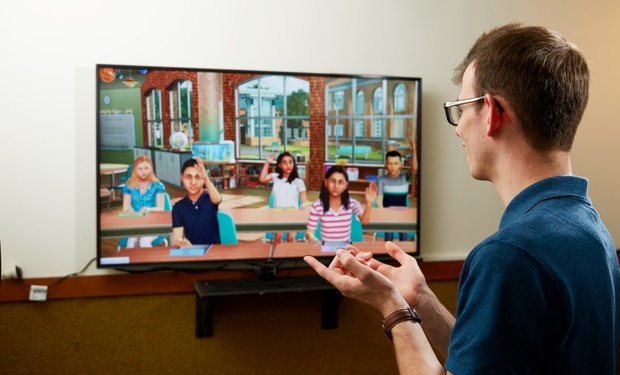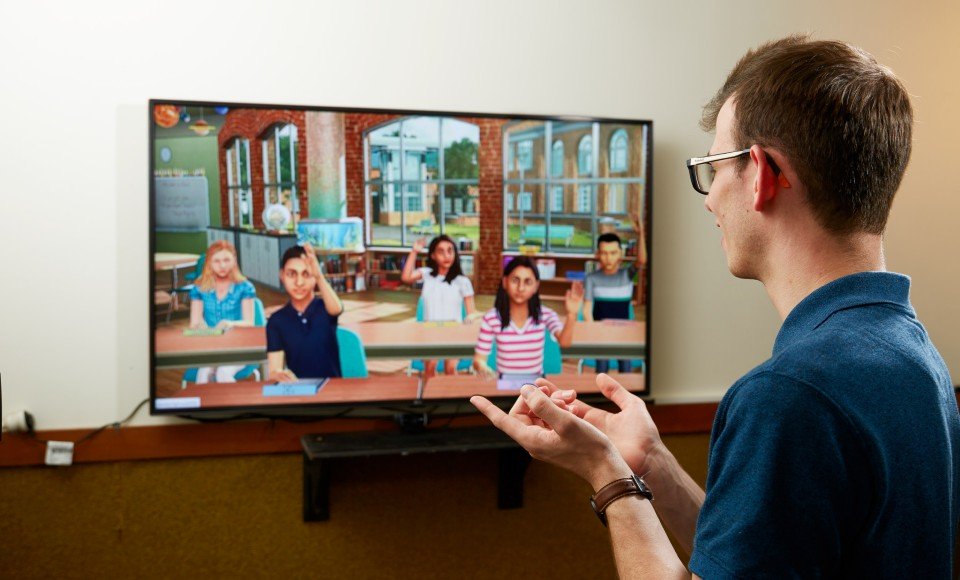The research suggests that simulations are a highly effective on-entry screening tool, providing prospective teachers with authentic classroom dynamics, and in the process increasing their confidence and providing them with a safe learning environment.
Murdoch University was the first in the country to implement teaching simulations and augmented learning environments into its general ITE course structure, using American Mursion technology, in the shape of SimLab – and with its groundbreaking integration of the technology in on-entry evaluation, it is once again forging a trail for others to follow.
Associate Professor Peter Whipp is Dean and Head of the School of Education at Murdoch and his most recent research has largely been about understanding how useful simulation tools can be in the initial screening of teaching students.
Prior to entering academia, Dr Whipp spent 17 years as a teacher in both primary and secondary schools.
He transferred from a role in UWA sports science in 2016 to Associate Dean for Teaching and Learning at Murdoch University where he met co-author of his recent paper, Professor Susan Ledger, who later drove the university’s forming of a partnership with Mursion.
While the focus of each learning institution naturally varies, in terms of pedagogical beliefs and dispositions, Murdoch University is focussed on an authentic experience.
“With my years of teaching in schools, it is my fundamental belief is that our candidates should experience something that is as realistic [as possible] and has utility to thinking,” Whipp tells EducationHQ.
“We thought it a wonderful opportunity that we could provide on entry, that very rich opportunity for candidates to represent themselves as a teacher – and that’s what we’ve managed to achieve.”
Ledger and Whipp have worked collaboratively to design the evaluation tool that sits behind the process to determine the non-academic dispositions that are part of ITE candidates’ makeup.
The candidates’ responses have been very encouraging, with most describing the exercise as a valid and reliable assessment of their non-academic dispositions, particularly around their rapport-building skills and their resilience, their conscientiousness, as predictors of their self-confidence to teach.
“We were looking for the predictive strengths of certain qualities, and the strength of association between the variables, and ultimately, our candidates suggested that this was a good measure of their improvisations skills, their rapport building and discourse, and these we know, are particularly important qualities for young people – and older – coming into ITE programs,” Whipp says.
But while the implications of the team’s findings are significant, particularly in terms of policy and practice, simulation is also hard work and, at present, quite an expensive undertaking.
“We have a significant staff, including actors who are employed and trained to represent the avatars,” Whipp concedes.
“We also have our SimLab clinical practitioners who provide feedback to candidates immediately after they’ve concluded their session and support those candidates to then come back and re-engage.”
Crucially, the candidates themselves are screened from the detailed work itself – the actors, for example, are in a room that is not visible to the candidates.
“In fact the candidates, by choice, are not provided full transparency about the human-looped technology,” Whipp says.
“It’s agreed that the magic is best hidden from the candidates, so it doesn’t cloud their perception of what they’re engaging with. Although they are avatars, we want them to believe that it’s a real experience, that they are alive and they are responding to what the candidate is doing and saying in that interaction.”
While Whipp concedes simulation, at present, is perhaps not a particularly cost-effective mechanism relative to, say, candidates supplying a 500-word written disposition on ‘why I want to be a teacher’, the advantages of the approach far outweigh any financial inhibitors.

“Our research showed that simulation can reliably evaluate students’ teaching dispositions, as well as provide insights into their motivations, planning, communication skills and how we can best support them," Dr Peter Whipp says.
“The business case and cost benefit are really at the forefront of our analysis of SimLab and we are of the belief that the positive outcomes – both measurable and immeasurable – provide good evidence as to why we should invest in this technology,” he says.
“We think it’s a worthy investment, to not only present ourselves as an authentic experience, but to motivate our candidates to understand the importance of the role of a teaching identity and start that immediately as they begin their course.”
The next steps in the research program include exploring the predictive nature of data captured at course entry and how this translates over time and experience.
“Our ultimate goal is to look at the learning experience journey of our candidates to marry up their achievements in professional experience, particularly the final professional experience that they have, before they graduate, to look at that performance relative to the on-entry screening performance that they have engaged with,” Whipp says.
“So be it over a two-year Master of Teaching, or be it a four-year BEd, we’re interested in the predictive aspects and the strength of associations between what we did on entry – and what happens at the exit point of their ITE program.”
As mentioned, the SimLab itself is used in many scaffolded ways and with sophistication that far exceeds its role as an on-entry screening tool.
“It’s a part of our assessment of learning, but it is also a part of our process for learning,” Whipp says.
At the near completion of courses, ITE candidates at Murdoch University are invited as a part of the SimLab unit to engage with an angry parent, providing another invaluable, if at times very uncomfortable, experience.
Interestingly, as part of developing the on-entry screening process, Whipp stepped into the SimLab to experience it firsthand.
“As someone who’s very experienced in the classroom, what I found SimLab does, is it ignites your inherent teaching disposition, as soon as you engage with it.
“It’s very intuitive as an experience to the real classroom situation.
“And as a teacher, you can’t help but be triggered to go into your teaching mode by the avatars, and although they’re not technically real, they’re on a TV screen and they are caricatures – it drives you, it drives the teacher entity that’s within.
“We can ask the interactor to change the level of classroom management needed, so we can literally say, 'can we have a naughty class?', or 'can we have a challenge around traditional classroom management needs?', and the actors can simply dial that up, they will respond accordingly. It can be really hard work.”
Of course, the simulator can include examples of all student types, including those with a disability, providing valuable insight into learning differences.
“We have a character in the suite named Nate, who is on the spectrum,” Whipp explains.
“Nate was created from a real-life character and his story and school experiences were used to create the challenges that Nate delivers…”
As well, at the near completion of courses, candidates are invited as a part of the unit to engage with an angry parent.
“So, our preservice teacher is confronted by an adult avatar that is expressing concern about the treatment or experience of their child and the teacher is required to manage that rather explosive situation.
“[Based on the encounter] from that they are counselled by the SimLab clinical practitioner, and then they re-engage with that angry parent as a learning experience.
“Candidates tell us that, whilst it’s very confronting, it’s one of the most powerful experiences they have in the SimLab suite.
“To defuse that situation, to use strategies that do not escalate the scenario and actually bring about a conciliatory or collaborative approach, you can imagine that’s a very important learning experience.”
The full study is available in the Journal of Education for Teaching, here.















